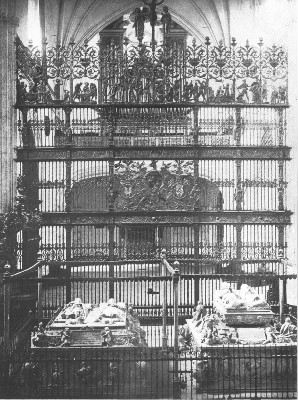THE BROCHURE SERIES |
THE | ||
| 1900. | MARCH | No. 2. |
SPANISH WROUGHT-IRON SCREENS.
From earliest times the numerous ironmines which exist in Spain, especiallyin the Cantabrian provinces,have been worked, and their presence hasdeveloped in that country excellent objectsof art in metal at all times; but owing tothe perishable character of iron, the slightintrinsic value of the material, and the littlecare taken of such fabrics, examples ofvery early specimens, with the exceptionof a few interesting ones which have reachedus from the Spanish Arabs, have disappeared.The most interesting examples ofMoorish manufacture which have survivedare some iron keys of most delicate tracery.Their perfect state of preservation showsthat they were used only as symbols ofcities or fortresses, and, on given occasions,offered to kings or great people,and even in the present day in Spain thisceremony is kept up, and a key signifyingthe freedom of the palace, is offered to theforeign princes who stay at the royal residencein Madrid. In a similar manner, asfar back as the middle ages, keys have beenpresented to Spanish sovereigns on occasionsof their visits to such towns as Toledoand Seville; and a ceremony of swearingthem to uphold the accorded privilege isgone through with,—a reminiscence probablyof what occurred when these townswere conquered from the Moors. One ofthese keys at Valencia, belonging to Countde Trignona, measures nine and-a-halfinches long, and was originally gilt. Itshandle is closed and covered with delicatework in relief, and the wards are ornamentedin the same manner with a combinationof several words written in Cuficletters of difficult interpretation; butaround the handle we can read distinctlyin arabic the name of the artist: "It wasmade by Ahmel Ahsan." This key appearsto date from the thirteenth or early fourteenthcentury, and two similar ones existin the Town Hall of Valencia.
Worthy objects of iron work must havebeen made by Christian artists of thisperiod in Spain, for, although no specimenshave come down to us, we have historicalinformation which confirms such aconclusion. In the ordinances of Barcelonawe find it recorded that the iron-smithsformed an extensive guild in thethirteenth century, and that in 1257 fourof its members were officers of the ChiefMunicipal Counci
